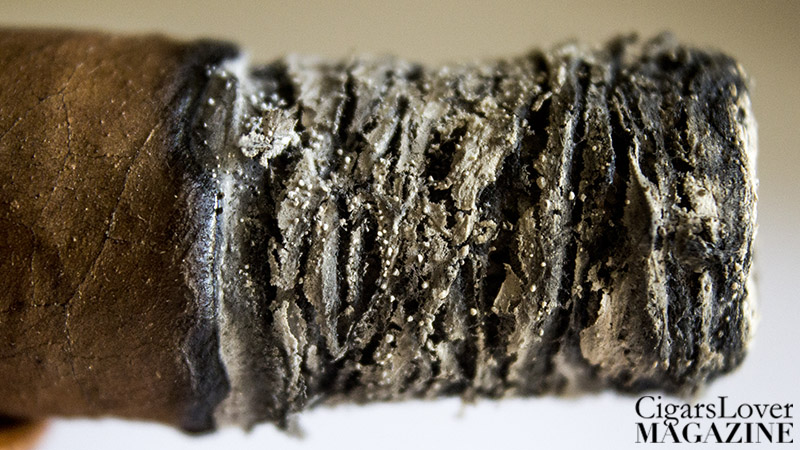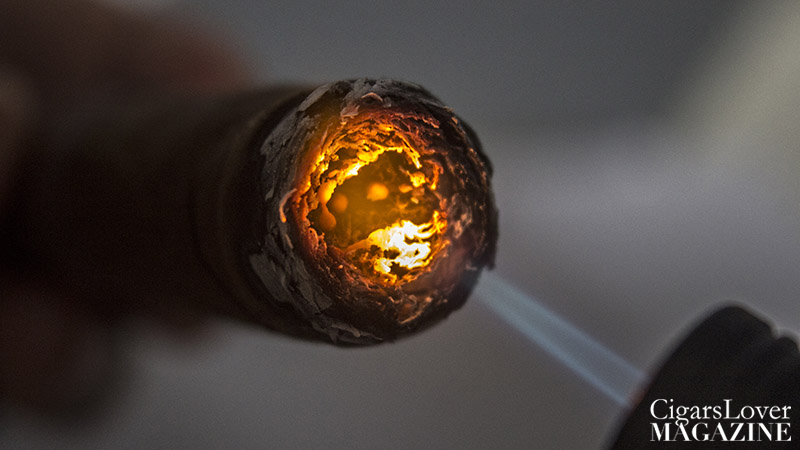Ash is capable of providing us with a lot of interesting info about our cigar.
-
White spots

Those white spots concretely show that the combustion is more complete in those particular areas. That means that for some reason, the combustion is improved on those spots or worsened around their direct vicinity.
Two ways seem obvious to suggest possible origin(s) of the phenomenon: the reason originating from outside or inside the wrapper leaf. In other words, we could assume that the manifestation of white spots over the wrapper during its combustion is due to a contact or a systemic source.
- CONTACT HYPOTHESIS – Some cigars are treated externally with products to improve the color of the wrapper (tone and homogeneity) and to boost the smell and taste of the tasting (additive). As those modified cigars should not be considered belonging to the premium family, let’s move on and only discuss genuine and quality cigars.
- SYSTEMIC HYPOTHESIS – We have to look at what is happening inside the leaf during its combustion. It thus involves their components and constituent chemistry. The burning process being a complex dynamic system, it is difficult to isolate a specific organic element that would explain and justify the appearance of white spots after the combustion of the cigar. The intrinsic composition of one cigar leaf is relatively stable but does vary in function of the area considered in the same leaf. Vegetal tissues do indeed vary in content and structure if we consider the stem, the central, the lateral areas, the tip, or the rear of the leaf. So yes there are differences in composition but are there important enough to justify – after the huge composition modification due to fermentation – differences in the ash color, and even more importantly, into the apparition of white spots? I do not think so.
Generally when present, those white spots are evenly distributed over the surface of the ashes’ cylinder and they are not only constrained within some delimited areas. Possible reasons should be searched into the direction of the leaf cytology, and especially elements that are in stable concentrations thorough the tissues of the plant. In the case of uneven distribution of spots, the origin is probably linked to the leaves composition, and it naturally or artificially caused heterogeneity. But then the areas with spots would be delimitated.
-
The “boiling ash” during the relighting of the cigar

This effect of ‘boiling’ the remaining oils of the leaves during the relighting of a cigar tends to happen generally when the cigar has had a bad combustion in the first place. Consequently it occurs more often when ashes are black or dark grey. The phenomenon does not develop so often on cigars showing good combustion and white to grey ashes. On a cigar with an average to bad combustion, ashes are not pure and still have significant quantities of unburnt organic fraction. Those residues give the darker color to the ashes, and they translate an excessive presence of biological compounds in the burnt material. When the lighter’s flame touches the ashes with its higher temperatures, the remaining organic fraction is then immediately and powerfully burned. This activation of the burning is sometimes so extreme that ashes might seem to boil. When it occurs gently the resulting residues are sometimes showing whiter colors than the original ashes. After a few minutes the taster can observe the trace of that in the form of lighter stratus in the ashes body corresponding to the moment of the cigar relighting.
The phenomenon of structural recombination – what is probably called the boiling drop in your question – is because the temperature of the lighter (around 800-1400 degrees Celsius) is much bigger than the temperature of the cigar combustion (around 600 degrees Celsius). This causes the structure of the ashes to be shocked by this temperature increase and thus suffer a recombination and structural change. This phenomenon is more observable when a strong flame is used (strong blue flame torch) than with a lighter flame (yellow flame regular lighter or match).
-
The more the ash is firm, the more the cigar of high-quality
Yes. By firm ashes we understand ashes that show a good and regular cylindrical structure without any falling fragments or opening portions.
Firm ashes reveal that the raw material just burnt had a good structure and that the combustion was complete. This means that the green leaves were well harvested and that the following processes of drying, fermentation, and rolling were well done as well. It is interesting to note that the combustion must also and always be well done to produce firm ashes. As a consequence, firm ashes have nice colors ranging from white to light grey.
Firm and black ashes are synonyms of poor cigar. Even though firm, black ashes still translate a misbalance in the leaves’ chemistry and the quality of the combustion, thus an unperfected delivery of aromas and flavors during the tasting. Good leaves with bad combustion will not give firm ashes. A lack of fermentation will also cause the structure to be softer than normal, and thus the ashes to be more friable.
Good leaves and good combustion are essential but not sufficient if the rolling is not properly done… A bad rolling will affect the quality of the ashes by affecting the combustion and its influence in case of a too tight or too soft draw.
A cigar composed with a generous amount of leaves – meaning too many leaves – will probably not have firm ashes. If too packed, the cigar will have a bad draw and thus an erratic combustion. But if the leaves are well produced and rolled with excellence even with a generous amount of tobacco – to a certain limit – combustion will be optimal.
-
The color of the ash

The color of the ashes is linked to the completeness of the combustion. A poor and inconsistent combustion will produce black ashes. A good combustion will produce nearly white ashes. In between, cigar ashes can show the whole variety of grey tones in the function of the completeness [quality] of the leaves combustion.
Now what are the criteria for a good combustion is the real question. And this is a vast query. Basically combustion is influenced by a huge amount of parameters.
The color of the ashes is a complex debate. Great soils with perfect nutrients concentrations can give dark ashes if for example drying and/or fermentation are not well done. Reversely, very average fields with some nutrient deficits can still give nicely colored ashes if processes are masterly done.
Ashes’ color – and cigar quality in general – should be seen as a multifaceted and interconnected complex with numerous influencing parameters. It is a complex system.
White ashes are generated by a complete combustion of the cigar leaves; when organic matters are nearly completely burned and leave behind almost pure mineral residues. This is the physics of combustion.
Now numerous factors can interfere and affect the quality and completeness of the combustion. The better the soil quality (in macro and micro-element compositions), the bigger the chances of a good combustion. But it is not the only one. Numerous other factors do influence the ashes’ color including the leaves’ genetic characteristics (linked to the species), the leaves drying (this has an influence on the leaves final content and structure), the fermentation (this also has an influence on the leaves final content and structure), the cigar rolling, the cigar aging, the cigar humidity during the tasting, the cigar environment when tasted, and…, and…, and…, and – last but not least – the way aficionado is tasting his/her cigar.
So great magnesium (Mg) and potassium (K) concentrations in the soil doesn’t always mean white ashes during the cigar combustion. Rich Mg and K contents in the soil clearly maximize the chances of having very balanced leaves composition, and finally – if subsequent production processes are optimal – a qualitative combustion during the tasting. But it is not enough to have white ashes. This is a parameter that is essential but not sufficient.
In conclusion, the white color of ashes is the result of a complete combustion and therefore the result of a whole series of elements and events. Everything is interconnected and a mono-parameter justification would be an erroneous answer. This is a multifaceted and dynamic complex system.
Article from CigarsLover Magazine, written by D. Houvenaghel.

